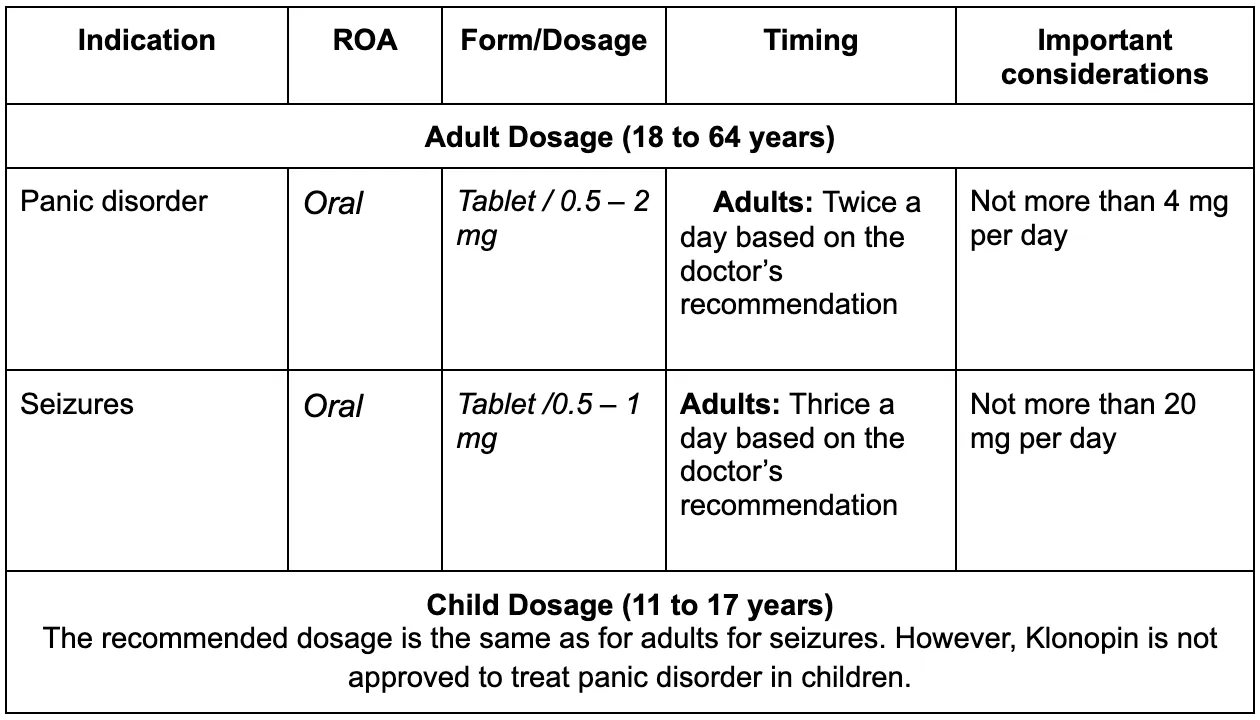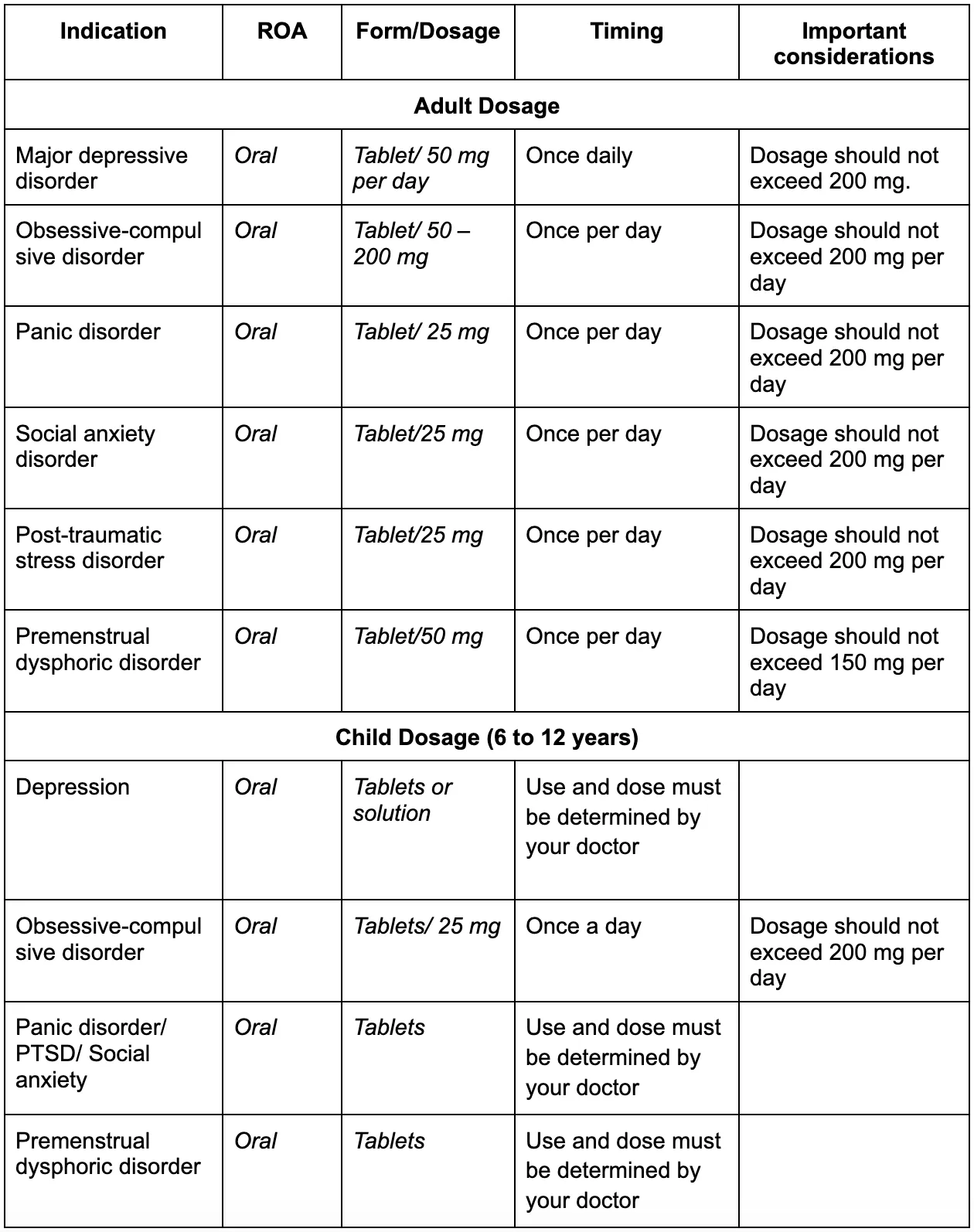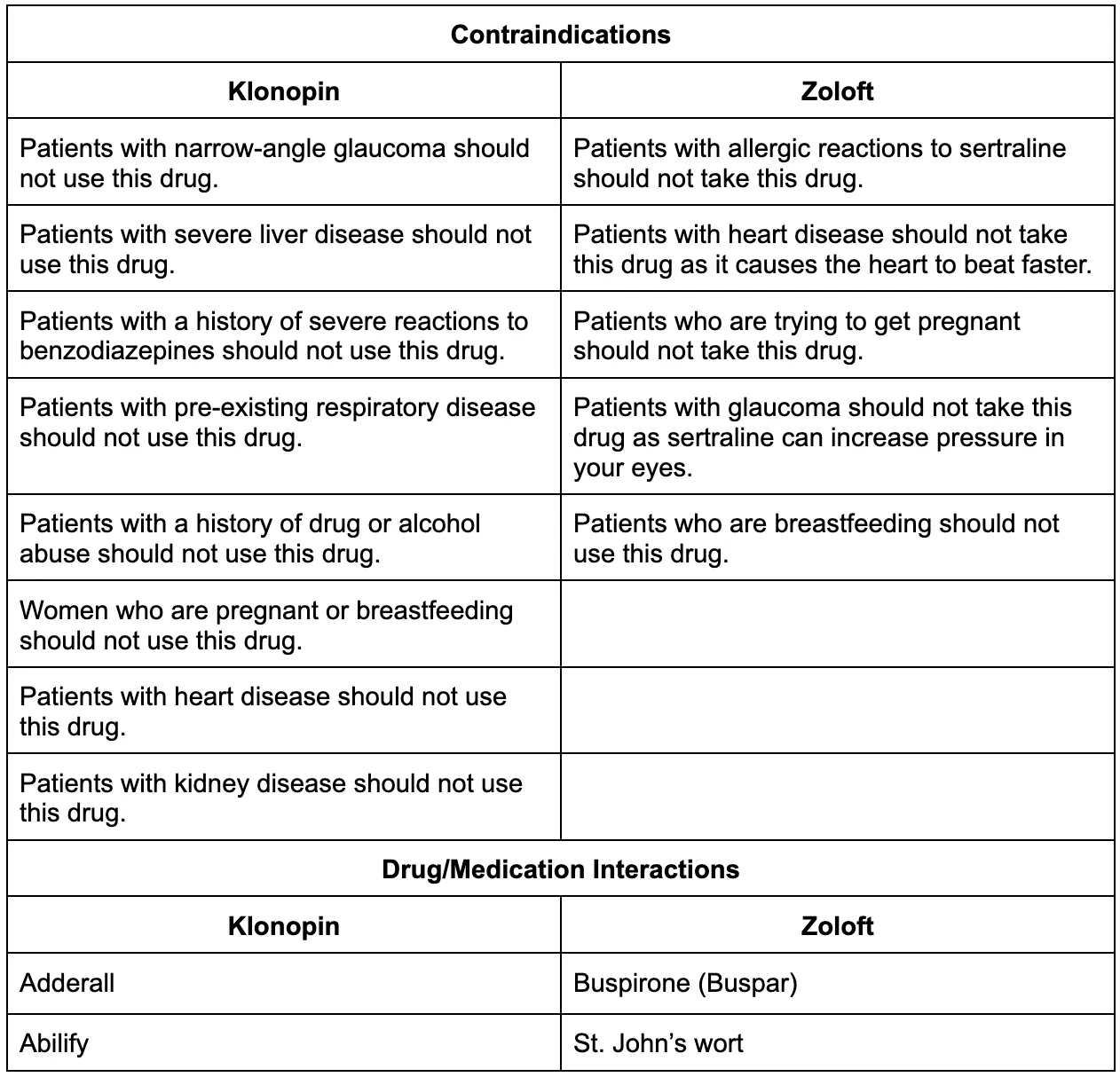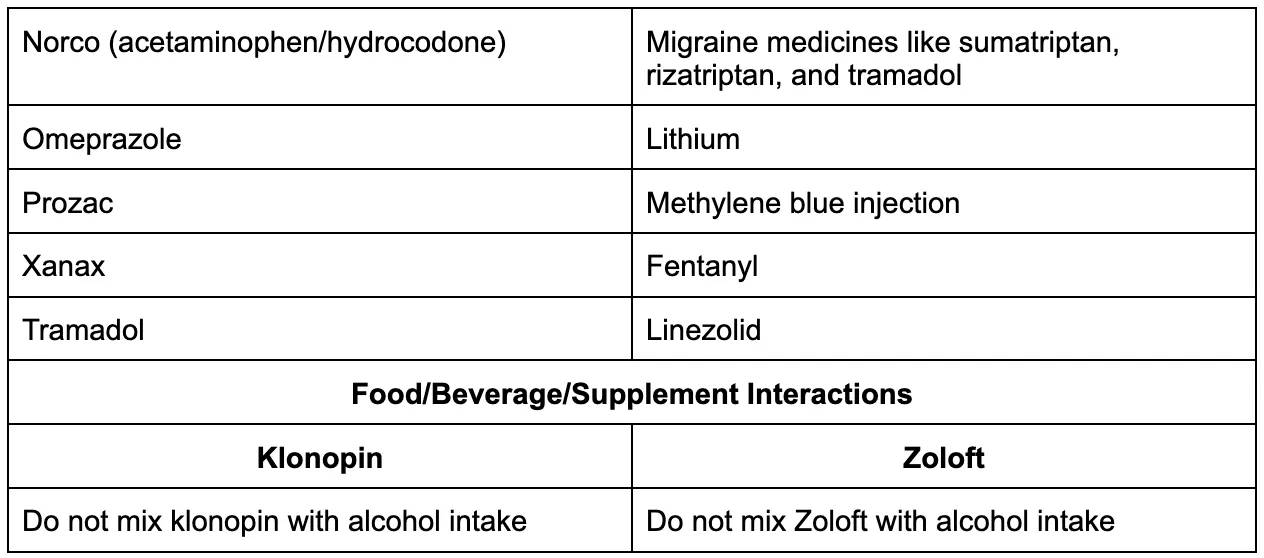Your session is about to expire
Klonopin vs Zoloft
Introduction
For patients seeking treatment for panic disorder, different classes of drugs are prescribed, such as Selective Serotonin Reuptake Inhibitors (SSRIs) and Benzodiazepines. SSRIs work to balance serotonin which is a neurotransmitter associated with mood and sleep-related functions.
Benzodiazepines, on the other hand, affect the GABA receptors of the brain and slow the central nervous system. While the two classes of drugs treat the same symptoms (in this case, symptoms of panic disorder), their chemical structures are different.
Benzodiazepines are psychotropic drugs with a core chemical structure consisting of the fusion of a diazepine and benzene ring. However, since there are different SSRIs involved in treating different conditions, the chemical composition within the category also differs. For example, sertraline is a popular category of SSRIs that mainly treats depression and sometimes panic disorder. Sertraline structure is mainly dominated by alpha helices, and it serves as a monoamine transporter protein transporting serotonin where it needs to.
Klonopin, a drug used to treat panic disorder symptoms, is a benzodiazepine, whereas Zoloft is an SSRI. This composition of each drug has implications in treatment plans whereby they’re prescribed to patients depending on their weight, history of the disease, overall health, and any other medications that may interfere with these categories.
About Klonopin and Zoloft
What is Klonopin?
Klonopin is a benzodiazepine that enhances the activity of certain brain neurotransmitters. While it mainly controls or prevents seizures, the medication can also treat panic attacks. It is also known as an anticonvulsant or antiepileptic drug. Clonazepam or Klonopin first became available in 1975, but initially, it was only suitable for treating epileptic seizures.
What Conditions Is Klonopin Approved To Treat?
Klonopin is approved by the FDA to treat the following conditions:
Seizure disorders such as:
Atonic seizures: Atonic seizures involve the muscles suddenly getting limp. In some cases, the entire body may become limp. Common symptoms include drooping of the eyelids, nodding or dropping forward of the head, and dropping things in general.
Myoclonic seizures: Myoclonic seizures are shock-like muscle jerks. They don’t usually last more than a second or two.
Absence seizures: These seizures can cause you to stare into space or blank out for a few seconds. They’re common in children and don’t usually result in long-term issues. They’re also known as petit mal seizures.
Panic disorder (in adults with or without agoraphobia): Panic disorder is a mental health condition that results in repeated panic attacks. It can occur with or without agoraphobia, which is a fear of being in crowded places. It’s important to note that Klonopin is often prescribed in combination with other medications.
How Does Klonopin Work for Panic Disorder?
Klonopin works by influencing the gamma-aminobutyric acid (GABA) receptors. They’re responsible for regulating various functions such as sleep, feelings of relaxation, excitement, etc.
The drug slows down your central nervous system by influencing the GABA receptors. As a result, your agitation and nervousness decrease, and a sense of relaxation and calm is induced.
However, this drug induces relaxation pretty quickly and isn't used for long-term treatment. Based on the doctor's recommendation, you may have to take it multiple times a day.
Benzodiazepines are among the most prescribed medications for panic disorder in the US. The US Food and Drug Administration has approved two forms of benzodiazepines for treating panic disorder:
Benzodiazepines are safe and well-tolerated, but their frequent use can cause dependence. If the treatment is ceased abruptly, there may be withdrawal symptoms.
What is Zoloft?
Zoloft is a brand name for sertraline, a selective serotonin reuptake inhibitor that balances serotonin levels in the brain and nerves. The scientists at Pfizer first developed this drug in 1991, but the history of sertraline goes back to the 1970s when a Pfizer chemist synthesized a norepinephrine reuptake inhibitor, tametraline.
Unfortunately, this development came to a halt due to undesirable effects observed in animals. A few years later, another chemist tested derivatives of the drug for serotonin reuptake inhibition, inventing sertraline as a result.
What Conditions Is Zoloft Approved to Treat?
The US Food and Drug Administration approved this drug in 1991 to treat depression. However, it is also majorly used to treat the following conditions:
- Panic disorder
- Obsessive-compulsive disorder
- Depressive psychosis
- Post-traumatic stress disorder
- Social anxiety disorder
- Premenstrual dysphoric disorder
- Arteriosclerotic Dementia w/ Depressive Features
- Dementia w/ Depressive Features
How Does Zoloft Work for Panic Disorder?
It's important to note that many professionals are not of the opinion that panic disorder is entirely a result of chemical imbalance in the brain. A combination of factors results in the development of this disorder, such as environmental and genetic factors. While Zoloft increases serotonin levels in the brain, it cannot eliminate other triggers that may be worsening a person’s symptoms.
The mechanism of action of sertraline is similar to the mechanism of action of other SSRIs. Its main function is to increase the amount of serotonin available in the brain by preventing the reuptake of serotonin at the receptors. When serotonin levels go up, its neurological effects also increase. Nonetheless, it's indisputable that the drug induces a fast response when treating mild depression, anxiety, or panic symptoms.
Effectiveness
How Effective Are Klonopin and Zoloft for Treating Panic Disorder?
According to a study by Sheng-Min Wang et al., clonazepam (a benzodiazepine) is just as effective as other benzodiazepines when treating different types of anxiety disorders. However, clonazepam is slightly safer than other benzodiazepines based on this study's findings.
In another study with 10 men and 14 women, the effects of clonazepam were tested against a placebo. There were 5 men and 9 women in the clonazepam group. On the other hand, there were 5 men and 5 women in the placebo group. Results revealed that only 11.1% of placebo patients experienced relief from panic attacks as compared to 61.5% of clonazepam patients who experienced relief.
Similarly, the effects of sertraline were tested against a placebo to determine its effectiveness in treating panic disorder. Results revealed that patients taking sertraline experienced an 88% drop in panic attacks per week as compared to a 53% drop in placebo-treated patients.
Another study with 93 patients in the sertraline group and 90 in the placebo group revealed that long-term sertraline treatment was effective in preventing panic disorder relapse. The drug causes very few discontinuation symptoms and is also well tolerated.
While both classes of drugs are equally effective in treating panic disorder symptoms, their combined effectiveness is also open to debate. So, a study tested the efficacy of combining sertraline with clonazepam in treating panic disorder. Results revealed that panic symptoms were much more stable with this drug combination than with sertraline alone.
Dosage information
How is Klonopin Administered for Panic Disorder?
Klonopin is usually taken orally for panic disorder. The dosage of this medication depends on various factors, such as:
- Your weight
- Age
- The severity of the condition
- Type of condition
- Other medical conditions you may have
Klonopin Dosage Information
Your doctor may prescribe a low dosage in the beginning based on the condition they're treating. For panic disorder, they may prescribe 0.25 mg twice a day. If there is no improvement in your symptoms after 3 days, they may increase the dosage to 0.5 mg twice a day. However, dosage adjustments are necessary until there is the right dosage for a specific condition. The maximum dosage should be no more than 4 mg per day.

How is Zoloft Administered for Panic Disorder?
Zoloft dosage information
Zoloft is administered orally regardless of the condition it is used to treat. The recommended dosage of Zoloft varies depending on the mental health disorder. Some populations react differently to the drug, so they may require adjustments as well as close monitoring by their doctor. Furthermore, it is not approved for children under 6 years of age.

Zoloft is also available in liquid form, but it isn't recommended if you have a latex allergy. If your doctor recommends taking it in liquid form, make sure to dilute it with half a cup of water, lemon-lime soda, or orange juice.
Side Effects
Each medication induces a different reaction in people based on the symptoms they are experiencing. The side effects also depend on factors such as medical history, overall health, anatomy, and interactions with other medicines. It's important to inform your healthcare professional about any medications you may be taking so you are well aware of the possible side effects.
What Are the Most-Common Side Effects of Klonopin?
The most common side effects of Klonopin include the following:
- Dizziness
- Drowsiness
- Coordination problems
- Increased saliva
- Difficulty remembering things
- Difficulty thinking
- Unsteadiness
- Blurred vision
- Frequent urination
- Changes in sex drive
- Joint or muscle pain
Are There Any Potential Serious Side Effects of Klonopin?
* If you experience any of these serious side effects, seek medical help immediately
- Swelling of the face, eyes, tongue, lips, and throat
- Rash
- Hives
- Difficulty swallowing
- Difficulty breathing
- Hoarseness
Klonopin is not recommended for pregnant women as it may cause unwanted effects on the fetus. Sometimes, it is also secreted in breast milk. So, breastfeeding while taking the drug is also not recommended. Avoid discontinuing the drug abruptly, especially after long-term use. Doing so can cause tremors, seizures, vomiting, cramping, and excessive sweating.
What Are the Most-Common Side Effects of Zoloft?
The most common side effects of Zoloft include the following:
- Dry mouth
- Dizziness
- Headaches
- Nausea
- Inability to sleep but still feeling sleepy
- Diarrhea
- Feeling weak or tired
Are there any potential serious side effects of Zoloft?
* If you experience any of these serious side effects, seek medical help immediately
- Heavy bleeding during menstruation
- Spotting or bleeding between periods
- Weight loss or gain without trying
- Feelings of overwhelming happiness/ excitement/ restlessness
- Skin turning yellow (it can be a sign of liver problems)
- Eyes turning yellow
- Coughing blood
- Blood in your pee
- Blood in your vomit
- Bleeding from the gums
- Bruises appearing without reason
Contraindications and interactions
Warnings and general precautions for Klonopin and Zoloft
The use of benzodiazepines such as Klonopin is linked with risks of abuse, addiction, and misuse. The misuse of this drug often occurs when people take it with alcohol or other illicit substances associated with adverse outcomes. The longer the treatment duration, the higher the risk of addiction. Abrupt discontinuation is not recommended as it may lead to withdrawal symptoms which can be life-threatening.
For Zoloft, make sure you determine how you react to this medicine before performing any chores or errands such as driving, using machines, etc. Taking this medicine without determining your body’s reaction to it can be dangerous as there’s a chance you might not be well-coordinated or alert.
Contraindications and important interactions for Flurbiprofen and Ibuprofen


Cost Comparison
How much do Klonopin and Zoloft cost?
For a 0.5 mg dosage and 100 tablets, the per unit cost of Klonopin is $2.78, which brings the total cost to $278.23. For a 100 mg dosage and 30 tablets, the per unit cost is $14.82, which brings the total cost to $444.61. The cost may vary depending on the dosage.
Popularity of Klonopin and Zoloft
For many people, Klonopin's popularity has to do with the fact that it can be prescribed to patients of all ages. With that comes the possibility of drug abuse. According to the 2013 National Survey for Drug Use and Health (NSDUH), about 2 million people older than 12 tried the drug non-medically for the first time in a year, which means there were about 5,500 new users every day. Furthermore, the estimated number of prescriptions in the United States was 14,758,212 in 2020.
On the other hand, Zoloft is the most commonly prescribed drug for depression, with more than 38 million prescriptions in the year 2017. The drug is also a part of the top 20 of all prescribed medications. The popularity of this drug has to do with its safety, efficacy, low cost, and tolerability.
While its mechanism of action for panic disorder can vary, Zoloft can produce immediate improvements for depression. It produces improvements in about a week or two after starting the medication. In 2020, the estimated number of patients using this drug was 7,768,366. According to Centers for Disease Control & Prevention statistics for 2015 to 2018, 13.2% of Americans over 18 years of age had taken the medication in the last 30 days.
While both drugs are equally popular in terms of treating different mental conditions, they also come with the added risk of addiction. Sticking to the prescription and avoiding abrupt discontinuation is the key to using Klonopin and Zoloft efficiently.
Conclusion
Takeaway
Klonopin and Zoloft have proved their efficacy time and again through drug trials, treatments, etc. The results they produce are backed not only by clinical studies but also records of treatment courses where they have proven to be effective.
While they both have their own side effects, proper monitoring and frequent consultations can prevent their onset. Based on various factors and the condition in question, both drugs can achieve similar results but through different mechanisms of action.
Since they have different compositions, they may not always produce the same results with every patient. In some cases, the results might not be as satisfactory in some patients as they are in others. This is because each patient has a different medical history and characteristics.
Both drugs have side effects, and both can interact with other drugs. So, it's best to consult your healthcare provider for more information about how each drug may interact with other drugs and what effects it may have on your health and well-being.